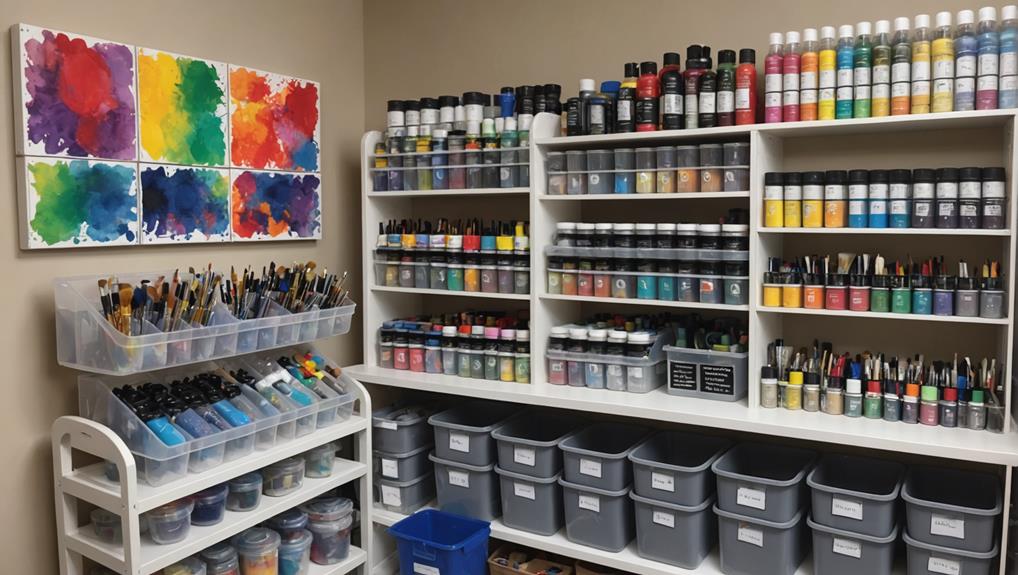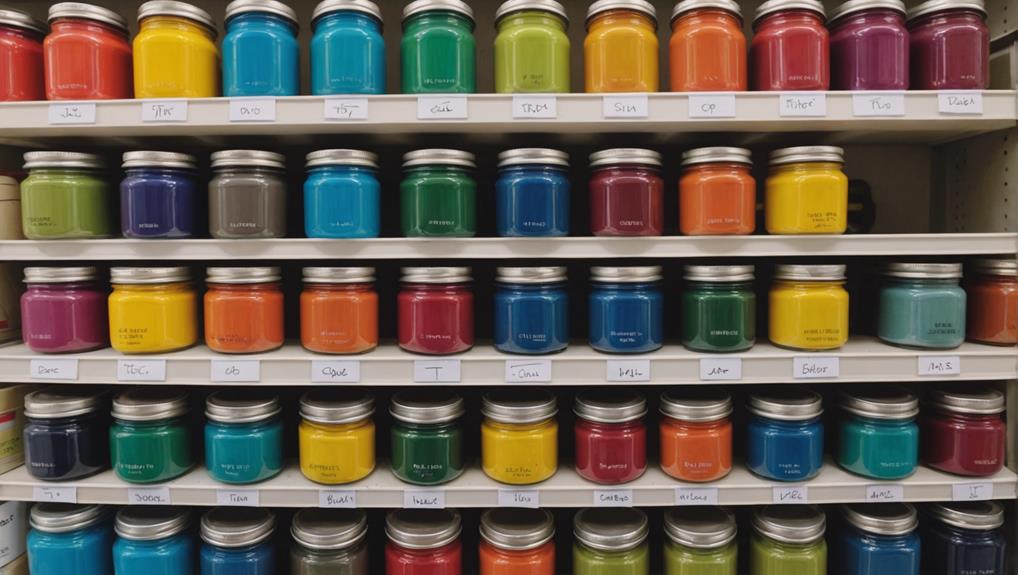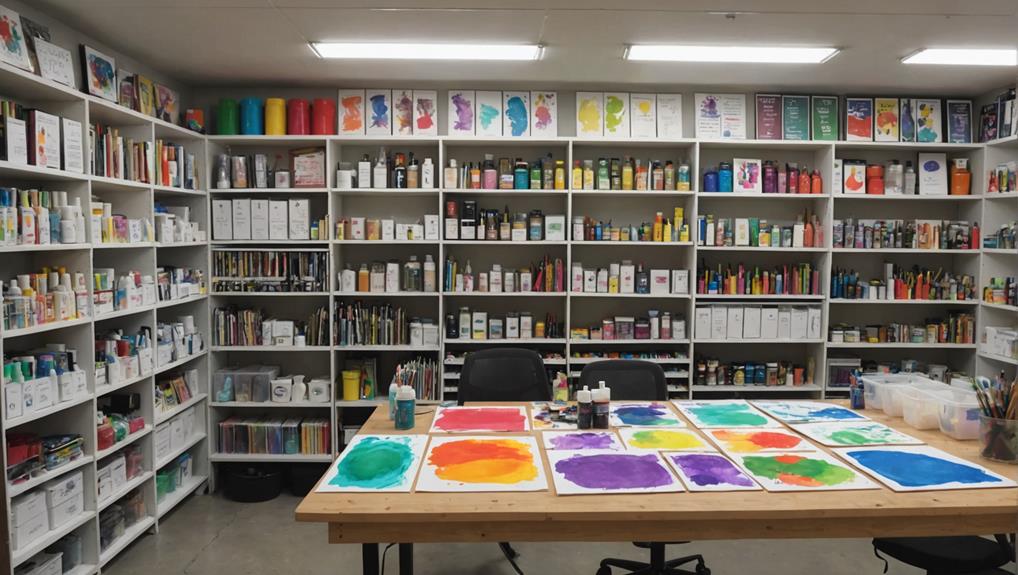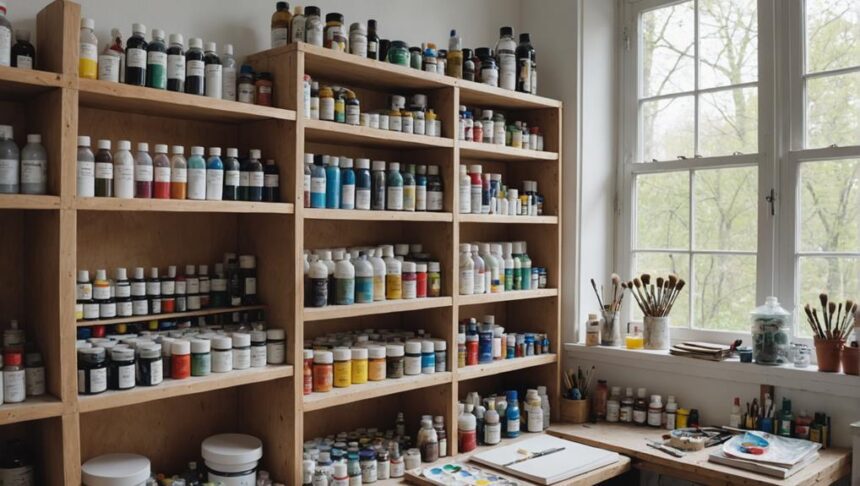Storing and maintaining your fluid art supplies is a bit like keeping a secret stash of magic potions! First, use airtight containers for your paints to keep them fresh and vibrant. Labeling helps you find the perfect color without digging through a mess. Squeeze bottles for mixed paints? Total game-changer! Brushes need some love too—clean them with mild soap, reshape, and store upright. Don’t forget a well-ventilated space to keep those creative vibes flowing safely. Got more tools? Organize them by size and purpose in clear containers. Ready to master your art gear and discover more cool tips?
Key Takeaways
- Use airtight containers to prevent acrylic paints from drying and maintain their quality.
- Label and color code containers to enhance visibility and organization of paints and mediums.
- Clean and reshape brushes immediately after use to preserve their longevity and performance.
- Store brushes upright and away from direct sunlight to prevent bristle damage.
Organizing Your Paint Supplies
Properly organizing your paint supplies is fundamental for maintaining their quality and guaranteeing efficiency during your fluid art projects.
A significant aspect of paint supply organization is color coding your acrylic paints. By storing them in airtight plastic tubs and arranging them by color, you not only prevent them from drying out but also make it much easier to find the shade you need quickly. This method saves you precious time, letting you focus more on your creativity.
For pre-mixed pouring paints, consider using clear, resealable bags. These bags should be tightly sealed to extend the usability of the paints for future sessions.
Keeping track of your pouring mediums is another critical part of your organization strategy. Use labeled containers to differentiate between commercial options and alternatives like Floetrol or PVA glue, which aids in quick selection during your painting process.
Additionally, implementing a labeling system for your paint tubes, noting the color and brand, helps you quickly identify the supplies needed for various pouring techniques.
Regularly checking and rotating your paint stock guarantees older supplies are used first, minimizing waste and ensuring you work with the best quality materials.
Selecting the Right Storage Containers
Choosing the right storage containers is vital for maintaining the quality and organization of your fluid art supplies.
Airtight containers are essential for preserving acrylic paints, while clear plastic bins or drawers help in categorizing items like pouring mediums and silicone oils.
Additionally, using labeled organizers or storage carts guarantees that all your mixing tools are easily accessible, making your creative process more efficient and enjoyable.
Airtight Containers for Paints
Selecting the right airtight containers is vital for preserving the quality and longevity of fluid art paints. Confirming your paints stay fresh is all about using proper paint preservation techniques and picking the best container material options. Airtight containers do the job perfectly by keeping air out, which prevents your paints from drying out or spoiling.
When it comes to container material options, BPA-free plastic is a winner. It’s durable and safe for your art supplies. Plus, clear containers are a fantastic choice because they let you see the paint colors without opening each one, which helps keep the paint’s quality intact. Think of it like a superhero shield for your paints!
Don’t forget to label each container with the paint brand and color. This makes your creative process smoother since you can quickly find what you need. Efficient organization is key to a stress-free art session.
Lastly, make sure to regularly check the seals of your containers. An airtight seal is essential for keeping your paints in top shape. So, give those lids a good look every now and then to confirm they’re still doing their job.
Organizing Mixing Tools Efficiently
Efficient organization of mixing tools is vital for maintaining an orderly and productive fluid art workspace. By selecting the right storage containers, you can streamline your mixing techniques and guarantee tool accessibility.
Start by using silicone cups for mixing paint; they’re great because the paint peels off easily once dried, making them reusable and eco-friendly. For those who want to be more environmentally conscious, biodegradable paper cups are a fantastic alternative.
Storing mixed paints in tight-lid containers is essential. This keeps your paints fresh and prevents them from drying out, which is especially important if you mix large batches. Squeeze bottles are another handy option for pre-mixed colors. They allow for precise, mess-free dispensing during your pouring sessions and can be easily labeled.
To keep your workspace organized, categorize mixing tools based on size and purpose. Use clear containers for easy identification, so you can quickly grab what you need without digging through piles of supplies.
This organization not only saves time but also enhances your creative process by keeping everything at your fingertips. With these simple yet effective storage solutions, you’ll maintain a tidy workspace and keep your creative juices flowing smoothly!
Labeling Systems for Accessibility
A well-implemented labeling system is essential for ensuring the accessibility and organization of fluid art supplies. Imagine reaching for your favorite pouring medium and easily spotting it thanks to a clearly labeled container. Using clear containers, you can separate paints, pouring mediums, and tools, making your creative sessions smoother.
To make this even easier, consider using color coding strategies. For example, use red labels for paints, blue for mediums, and green for tools. This way, you can grab what you need at a glance. Stackable storage bins with lids are fantastic for keeping everything dust-free and utilizing vertical space effectively.
A label maker is your best friend here. It lets you create neat, easily updated labels, which is vital for inventory tracking. As your collection of supplies grows or changes, simply update the labels to keep everything current and functional.
Regularly reviewing and reorganizing your storage system is key. This helps maintain efficiency and adapt to new supplies and techniques you might try. With a little effort, your fluid art workspace can be a well-organized haven, making your creative process more enjoyable and less stressful.
Maintaining Acrylic Paints

Proper maintenance of acrylic paints is vital for guaranteeing their longevity and performance in fluid art projects. Acrylic paints, known for their vibrant hues and versatility, require careful handling to maintain color consistency and paint longevity.
Storing your acrylic paints in airtight plastic tubs is important as it prevents them from drying out and helps keep their consistency intact over time. Always wipe the edges of paint containers before sealing them to guarantee a tight seal, preventing the lid from sticking and the paint from drying inside.
It’s also important to store these paints in a stable temperature environment, ideally between 60°F and 80°F (15°C to 27°C). Extreme temperatures can compromise paint quality and affect your art’s final appearance.
Regularly check your paints for signs of separation or drying. If you notice any issues, remix or safely dispose of the compromised paints to avoid affecting your projects.
Cleaning and Storing Brushes
Maintaining the longevity and performance of your brushes begins with immediate cleaning after use to prevent acrylic paint from drying and damaging the bristles. Start by rinsing your brushes with lukewarm water and mild soap—this simple step in brush maintenance can make a significant difference. For a deeper clean, periodically use specialized brush cleaners to remove any residual paint buildup and keep your brushes in prime shape.
When it comes to storing your brushes, it’s vital to allow them to dry properly. Store them upright in jars or containers to maintain their shape and avoid any bending or deformation of the bristles. For short-term storage, wrap the brush heads in cling film and place them in an airtight bag to keep them moist and prevent the paint from drying out.
Regular inspection is also a key part of brush maintenance. Check your brushes for signs of wear and tear, and be prepared to replace any that show significant damage to guarantee they perform at their best in your fluid art projects.
Here’s a quick reference table to help you visualize proper brush care:
| Task | Description |
|---|---|
| Immediate Cleaning | Rinse with lukewarm water and mild soap |
| Deep Cleaning | Use specialized brush cleaners periodically |
| Proper Storage | Store upright in jars or containers |
| Short-term Storage | Wrap heads in cling film, place in airtight bag |
Regular care and attention to your brushes will keep them in excellent condition, enhancing your fluid art experience.
Storing Mixed Paints

After ensuring your brushes are clean and well-stored, attention must be given to properly storing your mixed paints to preserve their quality and usability.
The key to paint longevity and color preservation lies in keeping paints from drying out and maintaining their consistency. Airtight containers are a must; they lock in moisture and prevent your carefully mixed colors from turning into unusable blobs.
For ease of use, consider placing pre-mixed colors in squeeze bottles. This not only makes dispensing a breeze but also helps in preserving the paint’s quality over time. If you’re not done with your palette, wrap it tightly in cling film. This simple step can keep your paints fresh temporarily until your next session.
It’s also important to store your mixed paints in a cool, dry place. Temperature fluctuations can degrade paint, so find a spot where the temperature remains steady.
Regularly check your stored paints for any signs of separation or drying. A quick remix can often bring them back to the desired consistency.
Proper Ventilation and Safety
Guaranteeing adequate ventilation in your workspace is vital for reducing the risk of inhaling harmful fumes from paints and mediums. Implementing effective ventilation techniques and adhering to safety protocols can markedly enhance your art studio environment. Here are some practical steps to maintain a safe and healthy workspace:
- Ventilation Techniques: Open windows or use fans to guarantee a constant flow of fresh air. This helps to dissipate fumes from paints and mediums, reducing their concentration in the air you breathe.
- Personal Protective Equipment (PPE): Always use nitrile gloves and masks when handling pouring mediums and additives. These materials can be harmful to your skin and respiratory system, so taking precautions is vital.
- Fire Safety: Keep a fire extinguisher readily accessible in your studio, particularly if you use heat sources like torches or heat guns. These tools are often necessary in fluid art but can pose fire risks if not managed properly.
- Proper Storage: Store all your paints, mediums, and solvents in a cool, dry place away from direct sunlight. This not only prolongs their shelf life but also prevents any potential chemical reactions that could be hazardous.
Engaging With the Art Community

Connecting with the art community can greatly enhance your fluid art journey, providing opportunities for learning, collaboration, and inspiration.
Imagine diving into a pool of creativity where everyone is enthusiastic to share their techniques and experiences. Engaging with fellow artists through online platforms like Instagram and Facebook can be incredibly rewarding. You can discover new trends, get inspired, and even find friends who share your passion for fluid art.
But don’t stop there! Participating in local art groups or community workshops is just as valuable. These in-person interactions offer a unique chance to get real-time feedback, which can be a game-changer for improving your skills. Plus, there’s something magical about collaborating on art projects and seeing different styles come together.
Joining forums dedicated to fluid art is another fantastic way to ask questions, share challenges, and receive advice from experienced artists. It’s like having a mini art class at your fingertips!
And don’t forget about the contests and challenges hosted by art supply brands. These events not only encourage you to showcase your work but also help you network with other artists, sparking new ideas for future art collaborations.
Exploring Storage Solutions
Proper storage solutions are essential for maintaining the quality and longevity of your fluid art supplies. Creative storage ideas and space optimization can make a huge difference, helping you keep everything organized and easily accessible.
First, using airtight containers for storing acrylic paints is a must. These containers prevent the paints from drying out since water-based paints can evaporate quickly when exposed to air.
Next, pouring mediums like Floetrol should be kept in cool, dark places to maintain their consistency. Temperature fluctuations can affect their effectiveness, so a stable environment is vital.
To keep your supplies organized, consider using clear bins or drawers for items like cups, mixing sticks, and silicone molds. This way, you can see everything at a glance and it encourages regular use.
Additionally, a good labeling system is important. Labeling your paint colors and mediums will streamline your art projects, saving you time and eliminating frustration when searching for specific items.
Finally, utilizing a pegboard or wall-mounted storage for tools and supplies can help you maximize vertical space and keep your workspace clutter-free.
- Airtight containers for acrylic paints
- Cool, dark storage for pouring mediums
- Clear bins or drawers for supplies
- Labeling system for all materials
Frequently Asked Questions
How Can I Store My Art Supplies?
To store your art supplies effectively, implement supply organization by using airtight containers for paints, clear bins for pouring mediums, and jars for brushes. These storage solutions guarantee longevity and easy access, preserving the quality of your materials.
How Do You Maintain Art Materials?
To maintain art materials effectively, prioritize art supply organization and regularly inspect them for wear. Clean brushes after each use, store paints and mediums in airtight containers, and protect from extreme temperatures to guarantee material longevity.
How Do You Protect Fluid Art?
To protect fluid art, apply a varnish or epoxy resin for surface protection. Store finished pieces in a cool, dry place away from sunlight. Guarantee fluid mediums and paints are in tightly sealed containers to maintain their quality.
How Do You Preserve Art Materials?
To guarantee art material longevity, employ preservation techniques such as storing acrylic paints in airtight containers, using sealed bottles for additives, and cleaning brushes thoroughly. Regularly inspect supplies for wear and store them in cool, dry environments.
Conclusion
To summarize, proper storage and maintenance of fluid art supplies are essential for ensuring their longevity and usability. This includes organizing paint supplies, selecting appropriate storage containers, maintaining acrylic paints, cleaning and storing brushes, and properly storing mixed paints.
Additionally, ensuring proper ventilation and safety measures, engaging with the art community, and exploring various storage solutions can greatly enhance the overall experience and efficiency in fluid art practices.
Implementing these strategies can lead to a more productive and enjoyable artistic process.


Leave a Reply